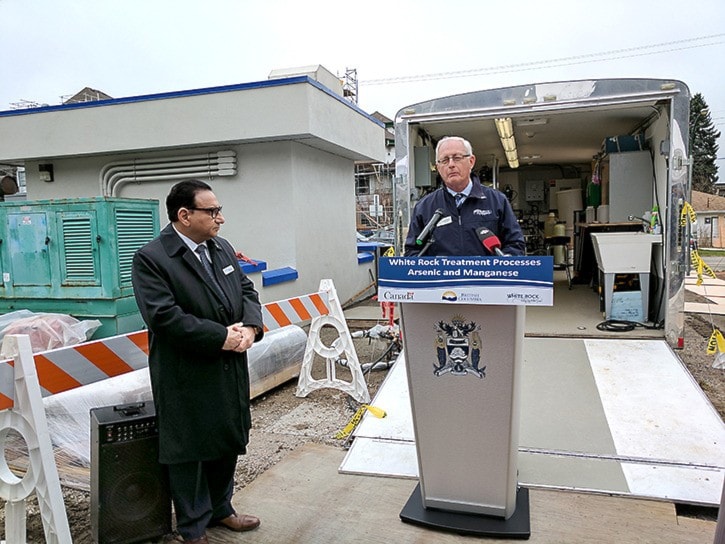The federal and provincial government announced a joint-funding contribution of $11,790,150 to the City of White Rock last week for planned arsenic and manganese treatment facilities for its water system.
The contribution – being touted as the largest grant approval in White Rock’s history – was announced at the Merklin Street well Friday afternoon. It includes $7,102,500 from the federal government and $4,687,650 from the province.
The city is to make up the remainder of the $14,205,000 project.
The senior-government money comes from the Clean Water and Wastewater Fund. A total of 144 projects benefited from announced funding, for a combined total of $373.2 million.
Of the 144, White Rock is to receive the third highest, behind Kelowna ($43.9 million) and West Kelowna ($41 million).
“It’s a very significant grant – probably the largest amount of money to flow to the city,” Surrey-White Rock MLA Gordon Hogg –who served on White Rock council from 1975 to 1993, the latter 10 years as mayor – told Peace Arch News. “I don’t remember many grants in the millions.”
Also announced on the city’s website Friday – but not raised at the earlier Merklin Street event – was that the city made an “advance payment” of $14 million to purchase the water utility from Epcor in 2015, and continues to work with the Edmonton-owned company on a final purchase price. (It was only revealed following the water-utility takeover that a price had yet to be agreed upon, and that the matter could be settled by arbitration.)
Friday’s media event was attended by about 35, including city staff and Couns. Megan Knight, Lynne Sinclair and Bill Lawrence.
“The grant would not have been available to the private owners,” Mayor Wayne Baldwin told the gathering. “At some point in the future, they would have been required to do this work by Fraser Health.”
He said the work was “inevitable.”
“The previous, private owner would have had to borrow the money. They would have borrowed it at a rate substantially higher than what the city would have borrowed it,” Baldwin said. “By purchasing this utility, by applying for and receiving this grant, our residents will not be paying down a $12-million loan. They will not be paying interest on the loan for the next 20 years.”
Last December, the city announced a contract with Res’eau-WaterNet, a research network based out of UBC. The team of scientists set up a mobile laboratory at the Merklin well to study treatment options for arsenic and manganese in the city’s water.
The research group has yet to announce the best treatment option for the city. The city hasn’t decided if it’s more appropriate to build two treatment centres, or just one, and have the water pumped to the secondary reservoir.
“We’re going to be doing value engineering,” city utilities manager Dr. Saad Jasim told Friday’s attendees. “We’re going to look at the economics, the treatment process and the sustainability for one system versus two. You need to look at all of these, because you don’t want a system which is maybe cheaper to build but the operating costs are way higher over 20 to 30 years.”
The project is expected to be complete by 2019 – a requirement of the government funding, Baldwin added.
“We’re working with all due haste on it. I don’t think (Res’eau-WaterNet is) at the point where they have a solution yet,” he said.
Following the announcement, Baldwin took questions from attendees.
Resident Patricia Kealy said she and her grandson are drinking bottled water (she later told PAN it’s because of manganese concerns), and she asked whether Baldwin would consider providing bottled water to schools.
Baldwin said there’s “no need” because water quality meets Health Canada guidelines.
Baldwin later approached PAN to expand on his answer, explaining why the city is following through with the treatment process even though he says the water is safe.
“The reason is… manganese at this point is a bit of an appearance issue because it combines with chlorine and discolours the water. That’s kind of a reason. But the arsenic does occasionally pop up not from the whole system, but from one or two wells,” Baldwin said. “If it blends in with the rest of the water, it’s OK, it’s not an issue. But it does pop up. What it’s saying to us, if it’s coming up now, at some point in the future it could be on a sustained basis and that’s not acceptable.”
Baldwin called it “forward thinking.”
“Epcor wasn’t going to do anything. They weren’t planning to do anything. But we think we have an obligation to the public even if it doesn’t make economic sense.”
In 2010, E.coli was discovered in city water and Fraser Health ordered secondary disinfection by June 30, 2016. Epcor was also notified that should arsenic and manganese levels exceed Health Canada’s guidelines, a treatment system must be operation before December 2018.
Shortly after purchasing the utility, the city confirmed that the levels of arsenic, in two out of seven wells, is occasionally higher than Health Canada’s maximum level.
To adhere to the secondary treatment requirement, city utility staff began adding chlorine to city water last Oct. 4. Since then, the city has received complaints from residents about the discolouration of their water. The reason, the city says, is due to the reaction between manganese and chlorine.
